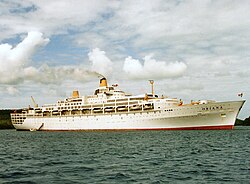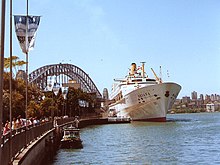Oriana (ship, 1960)
|
The Oriana 1985 off Tonga
|
||||||||||||||||||||||||||
|
||||||||||||||||||||||||||
|
||||||||||||||||||||||||||
|
||||||||||||||||||||||||||
|
||||||||||||||||||||||||||
|
||||||||||||||||||||||||||
The Oriana was a British passenger ship that was used in the Great Britain - Australia service of the P&O Orient Line and later in the cruise service.
history
Planning and construction
The Orient Steam Navigation Company (Orient Line) had been planning a new building since 1954, which was originally to be named Orbustus . In 1956 the new ship was finally commissioned. It should be used on the route to Australia and replace the aging ships of the line Orontes and Orion . The name Oriana was chosen to honor the former Queen Elizabeth I , whose nickname was Oriana .
The keel laying for the ship took place on September 18, 1956. The launch took place on November 3, 1959.
period of service
On December 3, 1960, the Oriana set out on her maiden voyage . From 1961, the steamer was used in liner service to Australia and New Zealand together with the Canberra , for the shipping company now trading as P & O-Orient Line Ltd after merging with the Peninsular and Oriental Steam Navigation Company in 1966 . She could carry over 2000 passengers in two classes. The hull, initially in a beige shade according to the Orient Line color scheme, was painted white in 1964. Due to the strong increase in air traffic, the declining number of emigrants to Australia and the closure of the Suez Canal , the two liners were no longer competitive at the beginning of the 1970s and were therefore converted into single-class cruise ships and used exclusively as cruise ships in the South Pacific from 1973. From 1981 the home port of the Oriana was Sydney . While the Canberra remained in service until 1997, the Oriana was retired in March 1986 and launched in Sydney.
Museum and tourist attraction
After two months of lay-in, the Oriana was sold and towed to the Japanese port city of Beppu , where it opened as a floating museum in 1987. In 1995 the ship was sold to China and, after extensive renovation work, was a tourist attraction and hotel ship in the port of Shanghai until 2002 ; it was then sold again and relocated to Dalian .
Damage from storm and scrapping
On June 16, 2004, the Oriana was badly damaged by a storm and was listed, so that the owners decided against repairs in view of the expected costs and sold the ship for scrapping. The steamer was towed to a Chinese scrapping yard on May 13, 2005 and scrapped there from June.
Others
The Oriana was the last passenger ship of the Orient Line and the last ship of the shipping company that still existed. The old name was given again in 1995 for the newly built cruise ship , which operated until 2019 for the P&O Cruises shipping company, which is now part of Carnival Corporation & plc .
literature
- Neil McCart: Oriana - The Last Great Ocean Liner Cheltenham: FAN Publications 1992, ISBN 0-9519538-0-X
Individual evidence
- ↑ P&O Heritage, Ship Fact Sheet, Oriana (1960) (English)
- ↑ P&O Heritage, Ship Fact Sheet, Oriana (1960) (English)
Web links
- The ship on faktaomfartyg.se (Swedish)
- Ship history at greatoceanliners.com (English)
- The Oriana at ssmaritime.com (English)


